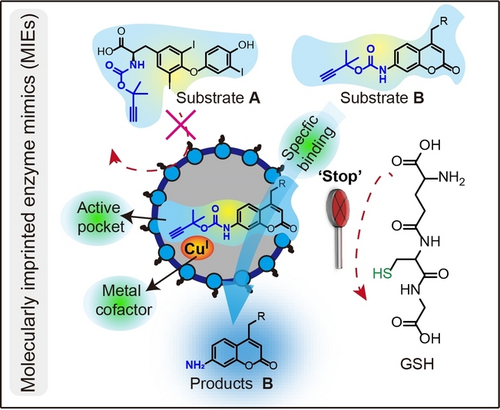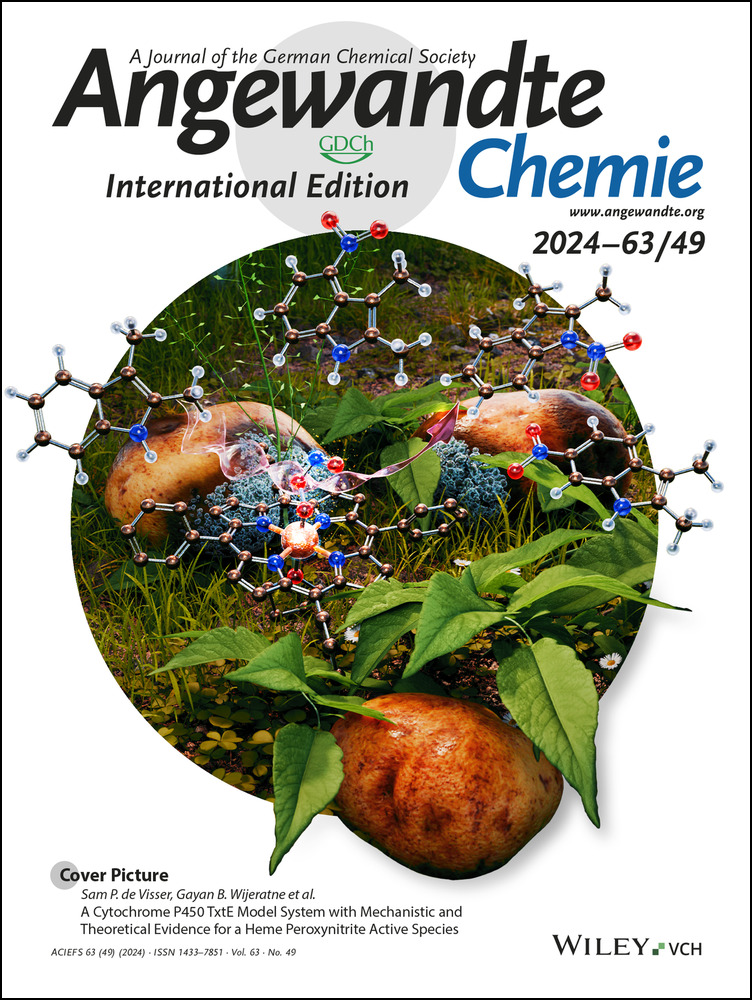Molecularly Imprinted Polymers for Highly Specific Bioorthogonal Catalysis Inside Cells
Dr. Zhiguo Gao
School of Chemistry and Chemical Engineering, Southeast University, Nanjing, 210089 China
State Key Laboratory of Natural Medicines, Jiangsu Key Laboratory of Drug Discovery for Metabolic Diseases, Center of Advanced Pharmaceuticals and Biomaterials, China Pharmaceutical University, Nanjing, 210009 China
These authors contributed equally.
Search for more papers by this authorQuanlin Shao
State Key Laboratory of Natural Medicines, Jiangsu Key Laboratory of Drug Discovery for Metabolic Diseases, Center of Advanced Pharmaceuticals and Biomaterials, China Pharmaceutical University, Nanjing, 210009 China
These authors contributed equally.
Search for more papers by this authorJiaqi Xing
State Key Laboratory of Natural Medicines, Jiangsu Key Laboratory of Drug Discovery for Metabolic Diseases, Center of Advanced Pharmaceuticals and Biomaterials, China Pharmaceutical University, Nanjing, 210009 China
Search for more papers by this authorYi Liang
State Key Laboratory of Natural Medicines, Jiangsu Key Laboratory of Drug Discovery for Metabolic Diseases, Center of Advanced Pharmaceuticals and Biomaterials, China Pharmaceutical University, Nanjing, 210009 China
Search for more papers by this authorFanzhen Meng
State Key Laboratory of Natural Medicines, Jiangsu Key Laboratory of Drug Discovery for Metabolic Diseases, Center of Advanced Pharmaceuticals and Biomaterials, China Pharmaceutical University, Nanjing, 210009 China
Search for more papers by this authorJian Chen
School of Chemistry and Chemical Engineering, Southeast University, Nanjing, 210089 China
Search for more papers by this authorCorresponding Author
Dr. Wei He
State Key Laboratory of Natural Medicines, Jiangsu Key Laboratory of Drug Discovery for Metabolic Diseases, Center of Advanced Pharmaceuticals and Biomaterials, China Pharmaceutical University, Nanjing, 210009 China
Search for more papers by this authorCorresponding Author
Dr. Yaojia Li
School of Life Sciences and Technology, Xinxiang Medical University, Xinxiang, 453003 China
Search for more papers by this authorCorresponding Author
Prof. Dr. Baiwang Sun
School of Chemistry and Chemical Engineering, Southeast University, Nanjing, 210089 China
Search for more papers by this authorDr. Zhiguo Gao
School of Chemistry and Chemical Engineering, Southeast University, Nanjing, 210089 China
State Key Laboratory of Natural Medicines, Jiangsu Key Laboratory of Drug Discovery for Metabolic Diseases, Center of Advanced Pharmaceuticals and Biomaterials, China Pharmaceutical University, Nanjing, 210009 China
These authors contributed equally.
Search for more papers by this authorQuanlin Shao
State Key Laboratory of Natural Medicines, Jiangsu Key Laboratory of Drug Discovery for Metabolic Diseases, Center of Advanced Pharmaceuticals and Biomaterials, China Pharmaceutical University, Nanjing, 210009 China
These authors contributed equally.
Search for more papers by this authorJiaqi Xing
State Key Laboratory of Natural Medicines, Jiangsu Key Laboratory of Drug Discovery for Metabolic Diseases, Center of Advanced Pharmaceuticals and Biomaterials, China Pharmaceutical University, Nanjing, 210009 China
Search for more papers by this authorYi Liang
State Key Laboratory of Natural Medicines, Jiangsu Key Laboratory of Drug Discovery for Metabolic Diseases, Center of Advanced Pharmaceuticals and Biomaterials, China Pharmaceutical University, Nanjing, 210009 China
Search for more papers by this authorFanzhen Meng
State Key Laboratory of Natural Medicines, Jiangsu Key Laboratory of Drug Discovery for Metabolic Diseases, Center of Advanced Pharmaceuticals and Biomaterials, China Pharmaceutical University, Nanjing, 210009 China
Search for more papers by this authorJian Chen
School of Chemistry and Chemical Engineering, Southeast University, Nanjing, 210089 China
Search for more papers by this authorCorresponding Author
Dr. Wei He
State Key Laboratory of Natural Medicines, Jiangsu Key Laboratory of Drug Discovery for Metabolic Diseases, Center of Advanced Pharmaceuticals and Biomaterials, China Pharmaceutical University, Nanjing, 210009 China
Search for more papers by this authorCorresponding Author
Dr. Yaojia Li
School of Life Sciences and Technology, Xinxiang Medical University, Xinxiang, 453003 China
Search for more papers by this authorCorresponding Author
Prof. Dr. Baiwang Sun
School of Chemistry and Chemical Engineering, Southeast University, Nanjing, 210089 China
Search for more papers by this authorGraphical Abstract
The molecularly imprinted enzyme mimics (MIEs) containing a copper center and specific substrate binding domain, could perform highly-specific abiotic transformation inside cells, particularly in a gain-of-functions. Importantly, Cu-MIEs exclusively catalyze target substrates and retain its superb performance even in the presence of copper-poisoning molecules like glutathione (GSH).
Abstract
Transition metal catalysts (TMCs) mediated bioorthogonal catalysis expand the chemical possibilities within cells. Developing synthetic TMCs tools that emulate the efficiency and specificity of natural metalloenzymes is a rewarding yet challenging endeavor. Here, we highlight the potential of molecularly imprinted enzyme mimics (MIEs) containing a Cu center and specific substrate binding domain, for conducing dimethylpropargyloxycarbonyl (DmProc) cleavage reactions within cells. Our studies reveal that the Cu-MIEs act as highly specific guides, precisely catalyzing target substrates, even in glutathione (GSH)-rich cellular environments. By adapting templates similar to the target substrates, we evolved Cu-MIEs activity to a high level and provided a method to broaden its scope to other unique substrates. This system was applied to a thyroid hormone (T3)-responsive gene switch model, inducing firefly luciferase expression by T3 in cells. This approach verifies that MIEs effectively rescue DmProc-bearing T3 prodrugs and seamlessly integrating themself into cellular biocatalytic networks.
Open Research
Data Availability Statement
The data that support the findings of this study are available in the supplementary material of this article.
Supporting Information
As a service to our authors and readers, this journal provides supporting information supplied by the authors. Such materials are peer reviewed and may be re-organized for online delivery, but are not copy-edited or typeset. Technical support issues arising from supporting information (other than missing files) should be addressed to the authors.
| Filename | Description |
|---|---|
| anie202409849-sup-0001-misc_information.pdf1.9 MB | Supporting Information |
Please note: The publisher is not responsible for the content or functionality of any supporting information supplied by the authors. Any queries (other than missing content) should be directed to the corresponding author for the article.
References
- 1
- 1aZ. Liu, M. Sun, W. Zhang, J. Ren, X. Qu, Angew. Chem. Int. Ed. 2023, 62, e202308396;
- 1bV. Sabatino, J. G. Rebelein, T. R. Ward, J. Am. Chem. Soc. 2019, 141, 17048;
- 1cA. Sousa-Castillo, A. Mariño-López, B. Puértolas, M. A. Correa-Duarte, Angew. Chem. Int. Ed. 2023, 62, e202215427;
- 1dF. Wang, Y. Zhang, Z. Du, J. Ren, X. Qu, Nat. Commun. 2018, 9, 1209.
- 2J. Li, J. Yu, J. Zhao, J. Wang, S. Zheng, S. Lin, L. Chen, M. Yang, S. Jia, X. Zhang, et al., Nat. Chem. 2014, 6, 352.
- 3
- 3aT. Völker, F. Dempwolff, P. L. Graumann, E. Meggers, Angew. Chem. Int. Ed. 2014, 53, 10536;
- 3bM. Tomás-Gamasa, M. Martínez-Calvo, J. R. Couceiro, J. L. Mascareñas, Nat. Commun. 2016, 7, 12538;
- 3cC. Streu, E. Meggers, Angew. Chem. Int. Ed. 2006, 45, 5645;
- 3dY. Long, B. Cao, X. Xiong, A. S. C. Chan, R. W.-Y. Sun, T. Zou, Angew. Chem. Int. Ed. 2021, 60, 4133.
- 4
- 4aJ. Chen, J. Wang, K. Li, Y. Wang, M. Gruebele, A. L. Ferguson, S. C. Zimmerman, J. Am. Chem. Soc. 2019, 141, 9693;
- 4bY. Liu, P. Turunen, B. F. M. de Waal, K. G. Blank, A. E. Rowan, A. R. A. Palmans, E. W. Meijer, Mol. Syst. Des. Eng. 2018, 3, 609.
- 5M. Jeschek, R. Reuter, T. Heinisch, C. Trindler, J. Klehr, S. Panke, T. R. Ward, Nature 2016, 537, 661.
- 6M. A. Miller, B. Askevold, H. Mikula, R. H. Kohler, D. Pirovich, R. Weissleder, Nat. Commun. 2017, 8, 15906.
- 7
- 7aR. Das, R. F. Landis, G. Y. Tonga, R. Cao-Milán, D. C. Luther, V. M. Rotello, ACS Nano 2019, 13, 229;
- 7bG. Y. Tonga, Y. Jeong, B. Duncan, T. Mizuhara, R. Mout, R. Das, S. T. Kim, Y.-C. Yeh, B. Yan, S. Hou, et al., Nat. Chem. 2015, 7, 597;
- 7cX. Zhang, Y. Liu, S. Gopalakrishnan, L. Castellanos-Garcia, G. Li, M. Malassiné, I. Uddin, R. Huang, D. C. Luther, R. W. Vachet, et al., ACS Nano 2020, 14, 4767.
- 8
- 8aS. Chordia, S. Narasimhan, A. Lucini Paioni, M. Baldus, G. Roelfes, Angew. Chem. Int. Ed. 2021, 60, 5913;
- 8bJ. Podtetenieff, A. Taglieber, E. Bill, E. J. Reijerse, M. T. Reetz, Angew. Chem. Int. Ed. 2010, 49, 5151.
- 9X. Qin, Y. Jiang, F. Yao, J. Chen, F. Kong, P. Zhao, L. Jin, Z. Cong, Angew. Chem. Int. Ed. 2023, 62, e202311259.
- 10L. Chen, X. Wang, W. Lu, X. Wu, J. Li, Chem. Soc. Rev. 2016, 45, 2137.
- 11D. Wu, W. Baaziz, B. Gu, M. Marinova, W. Y. Hernández, W. Zhou, E. I. Vovk, O. Ersen, O. V. Safonova, A. Addad, et al., Nat. Catal. 2021, 4, 595.
- 12
- 12aX. Li, T. M. Palhano Zanela, E. S. Underbakke, Y. Zhao, J. Am. Chem. Soc. 2021, 143, 639;
- 12bZ. Gu, Y. Dong, S. Xu, L. Wang, Z. Liu, Angew. Chem. Int. Ed. 2021, 60, 2663;
- 12cI. Bose, Y. Zhao, ACS Catal. 2022, 12, 3444.
- 13M. D. Arifuzzaman, Y. Zhao, ACS Catal. 2018, 8, 8154.
- 14
- 14aJ. K. Awino, R. W. Gunasekara, Y. Zhao, J. Am. Chem. Soc. 2016, 138, 9759;
- 14bJ. K. Awino, Y. Zhao, J. Am. Chem. Soc. 2013, 135, 12552.
- 15
- 15aJ. Xu, E. Prost, K. Haupt, B. Tse Sum Bui, Sens. Actuators B 2018, 258, 10;
- 15bM. Bompart, Y. de Wilde, K. Haupt, Adv. Mater. 2010, A22, 2343;
- 15cY. Fuchs, O. Soppera, A. G. Mayes, K. Haupt, Adv. Mater. 2013, 25, 566;
- 15dL. M. García-Con, M. J. Whitcombe, E. V. Piletska, S. A. Piletsky, Angew. Chem. Int. Ed. 2010, 49, 4075;
- 15eA. Poma, A. Guerreiro, M. J. Whitcombe, E. V. Piletska, A. P. F. Turner, S. A. Piletsky, Adv. Funct. Mater. 2013, 23, 2821;
- 15fL. Ye, I. Surugiu, K. Haupt, Anal. Chem. 2002, 74, 959.
- 16F. Canfarotta, A. Poma, A. Guerreiro, S. Piletsky, Nat. Protoc. 2016, 11, 443.
- 17X. Wang, Y. Liu, X. Fan, J. Wang, W. S. C. Ngai, H. Zhang, J. Li, G. Zhang, J. Lin, P. R. Chen, J. Am. Chem. Soc. 2019, 141, 17133.
- 18Z. Gao, Y. Li, Z. Liu, Y. Zhang, F. Chen, P. An, W. Lu, J. Hu, C. You, J. Xu, et al., Nano Lett. 2021, 21, 3401.
- 19S. Li, L. Wang, F. Yu, Z. Zhu, D. Shobaki, H. Chen, M. Wang, J. Wang, G. Qin, U. J. Erasquin, et al., Chem. Sci. 2017, 8, 2107.
- 20S. Eda, I. Nasibullin, K. Vong, N. Kudo, M. Yoshida, A. Kurbangalieva, K. Tanaka, Nat. Catal. 2019, 2, 780.
- 21
- 21aL. Wang, M. Tran, E. D′Este, J. Roberti, B. Koch, L. Xue, K. Johnsson, Nat. Chem. 2020, 12, 165;
- 21bG. Srinivasrao, J.-E. Park, S. Kim, M. Ahn, C. Cheong, K.-Y. Nam, P. Gunasekaran, E. Hwang, N.-H. Kim, S. Y. Shin, et al., PLoS One 2014, 9, e107432.
- 22P. Saxena, G. Charpin-El Hamri, M. Folcher, H. Zulewski, M. Fussenegger, Proc. Natl. Acad. Sci. USA 2016, 113, 1244.
- 23G. Woronoff, A. El Harrak, E. Mayot, O. Schicke, O. J. Miller, P. Soumillion, A. D. Griffiths, M. Ryckelynck, Anal. Chem. 2011, 83, 2852.
- 24X. Li, T. M. Palhano Zanela, E. S. Underbakke, Y. Zhao, J. Am. Chem. Soc. 2021, 143, 639.





